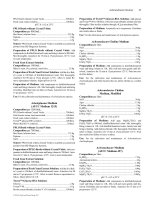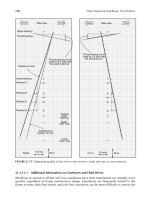Applications of Robotics and Artificial Intelligence Part 6 ppsx
Bạn đang xem bản rút gọn của tài liệu. Xem và tải ngay bản đầy đủ của tài liệu tại đây (28.8 KB, 20 trang )
APPLICATIONS OF ROBOTICS AND ARTIFICIAL INTELLIGENCE
Get any book for free on: www.Abika.com
101
diagnosis) in regular use at San Francisco
Hospital. Expert systems' behavior in
research laboratories and the civilian
sector is cause for optimism in the
military sector.
One can consider expert-systems support not
only at the corps and division levels but
also for battalions and regiments. As
envisioned in the Air Land Battle 2000
scenario, battalion and regimental
formations will be operating in forward
battle areas in a dispersed manner. Expert-
system support at this level will be
particularly helpful in increasing combat
effectiveness through flexibility and
adaptability to varied, complex situations
and improved survivability of men and
machines.
Although there is cause for optimism,
current expert systems have significant
limitations and require intensive basic
research if the technology is to be
successfully transferred from the
university laboratory to make rugged
operational systems.
Present expert systems support only narrow
domains of expertise. As the domain of
application becomes broader, the number of
alternative courses of action increases
APPLICATIONS OF ROBOTICS AND ARTIFICIAL INTELLIGENCE
Get any book for free on: www.Abika.com
102
exponentially and effectiveness decreases
exponentially. Though research is
addressing this issue, practical expert
systems are likely to be severely
restricted in their domain for the next 5
years.
Only limited knowledge-representation
languages for data and relations are
available.
The input and output of most expert systems
are inflexible and not in English (or any
other natural language).
Expert systems still require laborious
construction approximately 10 man-years
for a sizable one.
Because present expert systems need one
domain expert in control to maintain
consistency in the knowledge data base,
they have only a single perspective on a
problem.
Many expert systems are difficult to
operate.
3 CRITERIA FOR SELECTION OF APPLICATIONS
The committee spent a great deal of time
developing criteria for the selection of
Army applications of robotics and
APPLICATIONS OF ROBOTICS AND ARTIFICIAL INTELLIGENCE
Get any book for free on: www.Abika.com
103
artificial intelligence. These criteria
were essential in guiding the work of the
committee; but beyond that, they are more
broadly applicable to future decisions by
the Army as well as by others. The criteria
for selecting applications reflect both the
immediate technological benefits and the
attitudinal and managerial considerations
that will affect the ultimate widespread
acceptance of the technology.
REASONS FOR APPLYING ROBOTICS
AND ARTIFICIAL INTELLIGENCE
The introduction of robotics and artificial
intelligence technology into the Army can
result in a number of benefits, among them
the following:
improved combat capabilities,
minimized exposure of personnel to
hazardous environments,
increased mission flexibility,
increased system reliability
reduced unit/life-cycle costs,
reduced manpower requirements,
simplified training.
APPLICATIONS OF ROBOTICS AND ARTIFICIAL INTELLIGENCE
Get any book for free on: www.Abika.com
104
In selecting applications from the much
larger list of possibilities, the committee
not only looked for opportunities to
achieve those benefits but also sought
affirmative answers to the following
questions: Army.
Will it perform, in the near term, an
essential task for the
Can its initial version be implemented in 2
to 3 years?
Can it be readily upgraded as more
sophisticated technology becomes available?
Does it tie in with existing, related
programs, including programs of the other
services?
Will it use the best technology available
in the scientific community?
These considerations should help to ensure
initial acceptance and continuing success
with these promising developing
technologies.
COMBINING SHORT-TERM AND LONG-TERM
OBJECTIVES
Initial short-term implementation should
provide a basis for future upgrading and
growth as the user gains experience and
APPLICATIONS OF ROBOTICS AND ARTIFICIAL INTELLIGENCE
Get any book for free on: www.Abika.com
105
confidence in working with equipment using
robotics and AI technology. To this end the
Army's program should be carefully
integrated and include short-term,
achievable objectives with growth projected
to meet long-term requirements.
As a result; some of the applications
chosen may at first appear to be
implementable in the short term by other
existing technologies with lower cost and
ease. However, such short-term expediency
may cause unwarranted and unintended delay
in the ultimately more cost-effective
application of new developing robot
technologies. To prevent this problem,
short-term applications should be
applied to existing, highly visible
systems,
reasonably afforded within the Army's
projected budget,
within the state of the art, requiring
development and engineering rather than
invention or research,
able to demonstrate an effective solution
to a critical Army need ,
achievable within 2 to 3 years,
APPLICATIONS OF ROBOTICS AND ARTIFICIAL INTELLIGENCE
Get any book for free on: www.Abika.com
106
not redundant with efforts in DARPA or the
other services.
On the other hand, the committee considered
long-term applications to be important
vehicles for advancing research in these
technologies and, in some cases, for
introducing useful applications of robotics
and artificial intelligence. These more
advanced applications would ultimately, at
reduced cost, assist in meeting the
changing requirements of the modern
battlefield envisioned in the Army's Air
Land Battle 2000 concept.
The principle that guided the committee's
selection of applications, therefore, was
to combine short-term and long-term
benefits; that is, to select applications
that can be implemented quickly to meet a
current need and, in addition, can be
upgraded over the next 10 years in ways
that advance the state of the art and
perform more complex functions for the
Army.
PLANNING FOR GROWTH
For the near term, using state of the art
technology and assuming that a
demonstration program starts in 1 1/2 to 2
years and continues for 2 years, the
APPLICATIONS OF ROBOTICS AND ARTIFICIAL INTELLIGENCE
Get any book for free on: www.Abika.com
107
committee recommends that projects be
selected based not
only on what is commercially available now
but also on technology that is likely to
become available within the next 2 years.
During the next 4 to 5 years, while the
Army is developing its demonstration
systems, annual expenditures by university,
industrial, government, and nonprofit
laboratories for R&D and for initial
applications will probably exceed several
hundred million dollars per year worldwide.
To be timely and cost effective, Army
demonstration systems should be designed in
such a way that these developments can be
incorporated without discarding earlier
versions.
It is therefore of the utmost importance to
specify, at the outset, maximum feasible
computer processor (and memory) power for
each application. Industry experience has
shown that the major deterrent to updating
and improving performance and functions has
been the choice of the "smallest" processor
to meet only the initial functional and
performance objectives.
It is at least as important to ensure that
this growth potential be protected during
development of the initial applications
APPLICATIONS OF ROBOTICS AND ARTIFICIAL INTELLIGENCE
Get any book for free on: www.Abika.com
108
Both industry and the Army have known
programmers with a propensity to expand
operating and other systems until they
occupy the entire capacity of design
processor and memory.
Robots are currently being developed that
incorporate external sensors permitting
modification of the sequence of motions,
the path, and manipulative activities of
the robot in an adaptive manner. The status
of the "dumb, deaf, and blind" robot is
being raised to that approaching an
"intelligent" automaton. This upgraded
system can automatically cope with changes
in its reasonably constrained environment.
The earliest adaptive robot systems are
just beginning to be incorporated into
production lines. Most of these Systems are
presently in an advanced development stage,
worked on by application engineers for
early introduction into production
facilities. Such Systems, called third-
generation robot Systems, are expected to
supplement the second-generation robot
Systems (having programmable control but
lacking sensors) in the next 2 to 3 years.
Shortly thereafter, as more and more
assembly operations are automated, they are
likely to become the dominant class of
robot Systems. In view of these
APPLICATIONS OF ROBOTICS AND ARTIFICIAL INTELLIGENCE
Get any book for free on: www.Abika.com
109
technological developments, the Army
demonstration Systems should, at the very
least, be based on the third-generation
robot Systems capable of being readily
upgraded with minimum change in the
internal hardware configuration, relying on
future additions of readily interfaceable
external sensors and software.
SELECTING APPLICATIONS TO ADVANCE
PARTICULAR TECHNOLOGIES
In addition to considering the benefits
that result from applying robotics and
artificial intelligence, the Army has the
opportunity to use its choice of
applications to take an active role in
advancing
particular technologies. Because robotics
and AI are developing. rapidly, the
committee believes that Army should support
a range of component technologies.
The two fields are at present separate, and
the possible applications can be divided
into those that are primarily robotics and
those that are primarily artificial
intelligence. The robotics applications can
be further divided into those that
primarily advance end-effector (hand)
APPLICATIONS OF ROBOTICS AND ARTIFICIAL INTELLIGENCE
Get any book for free on: www.Abika.com
110
technology and those that primarily advance
sensor technology.
The AI applications can be divided into a
number of types, of which the furthest
developed is expert systems. The committee
limited its consideration of AI
applications to expert systems, in keeping
with its goal of short-term implementation
of limited aspects. The primary technology
for expert systems is cognition.
Each of these areas effectors, sensors,
and cognition is an important source of
technology for the Army and for this
country's industrial base. To encourage R&D
in these areas and to enable the Army to
have some initial experience in each area,
the committee agreed to recommend three
applications, one directed at each.
4 RECOMMENDED APPLICATIONS AND PRIORITIES
The committee used the criteria described
in Chapter 3 to develop an initial list of
10 possible Army applications of robotics
and artificial intelligence. These were
discussed at length and narrowed to six
applications that met the criteria, three
of which are strongly recommended.
Many hours of committee discussion are
reflected in the following list. The
APPLICATIONS OF ROBOTICS AND ARTIFICIAL INTELLIGENCE
Get any book for free on: www.Abika.com
111
committee found it impossible to match the
large numbers of possible applications and
criteria in any systematic way. No two
groups applying the criteria would arrive
at identical lists of Army projects to
recommend. The applications recommended
below are eminently worthwhile in the
judgment of the committee. They clearly
address current Army needs, offer short-
term benefits, are likely to give Army
personnel some positive early experiences
with the technology, and are capable of
being upgraded.
AN INITIAL LIST
With these considerations in mind, the
committee developed the following list of
10 potential applications of robotics and
artificial intelligence. Not all of these
applications are recommended by the
committee; this list is the result of the
committee 's first effort to narrow down
the vast number of possible applications to
those most likely to meet the criteria
described earlier.
Automatic Loader of Ammunition in Tanks.
This system would require development of a
robot arm with minimum degrees of freedom
for use within the tank. The arm would be
capable of acquiring rounds from a magazine
APPLICATIONS OF ROBOTICS AND ARTIFICIAL INTELLIGENCE
Get any book for free on: www.Abika.com
112
or rack and loading them into the gun, with
a vision system to provide the means to
correct for imprecise positioning of rounds
and gun and tactile or force sensors to
ensure adequate acquisition.
Sentry Robot. A portable unattended sentry
device would detect and report the presence
of personnel or vehicles within a
designated area or along a specified route.
The device would also be capable of sensing
the presence of nuclear, biological, and
chemical contaminants.
Flexible Material-Handling Modules.
Adaptive robots mounted on wheeled or
tracked vehicles would identify and acquire
packages or pallets to load or unload.
There are so many potential applications
for material-handling systems that
material-handling robots are likely to
become as ubiquitous as the jeep in the
Army supply system, with applications in
forward as well as rear areas.
Robotic Refueling of Vehicles. A wheeled
robot fitted with an appropriate fuel
dispenser (a tool for inserting into a fuel
inlet) could automatically refuel a variety
of vehicles.
Counter-Mine System. Adaptive robots
mounted on wheeled or tracked vehicles
APPLICATIONS OF ROBOTICS AND ARTIFICIAL INTELLIGENCE
Get any book for free on: www.Abika.com
113
could be fitted with specialized sensors
and probing or digging tools to find and
dispose of buried mines. Vehicles could be
remotely controlled in the teleoperator
mode.
Robot Reconnaissance Vehicle. The remotely
controlled reconnaissance vehicle that the
Army is considering as a major
demonstration project could be fitted with
one or more external robot arms and
equipped with vision and other sensors.
This would expand the utility of the system
to perform manipulative functions in
forward, exposed areas, such as retrieval
of disabled equipment; sampling and
handling nuclear, biological, and
chemically active materials (NBC); and
limited decontamination.
Airborne Surveillance Robot. A
semiautonomous aerial platform fitted with
sensors could observe large areas, provide
weather data, detect and identify targets,
and measure levels of NBC contamination.
Intelligent Maintenance, Diagnosis, and
Repair System. An ES, specialized for a
particular piece of equipment, would give
advice to the relatively untrained on how
to operate, diagnose, maintain, and repair
relatively complex electronic, mechanical,
APPLICATIONS OF ROBOTICS AND ARTIFICIAL INTELLIGENCE
Get any book for free on: www.Abika.com
114
or electromechanical equipment. It would
also act as a record of repairs,
maintenance procedures, and other
information for each major item of
equipment.
Medical Expert System. This system would
give advice on the diagnosis and evacuation
of wounded personnel. A trained but not
necessarily professional operator would
enter relevant information (after prompting
by the system) regarding the condition of
the wounded individual, including any
results of initial medical examination. The
system would logically evaluate the
relative seriousness of the wound and
suggest disposition and priority. This
system could be improved by having
available a complete past medical record of
the individual to be entered into the
system prior to asking for its advice.
Battalion Information Management System.
This system would provide guidance and
assistance in situation assessment,
planning, and decisionmaking. Included
would be the automatic or semiautomatic
production of situation maps, plans,
orders, and status reports. It also would
include guidance for operator actions in
response to specific situations or
conditions.
APPLICATIONS OF ROBOTICS AND ARTIFICIAL INTELLIGENCE
Get any book for free on: www.Abika.com
115
Although this list represents a
considerable reduction from the many
possible applications that have been
conceived, a further narrowing is needed.
Knowledgeable researchers and other
resources are in such short supply that
Army efforts in AI and robotics should
be well thought out and focused. The
remainder of this chapter presents in more
detail the functions, requisite technology,
and expected benefits of the committee's
top six priorities.
As noted in Chapter 3, the committee
recommends that the Army fund three
demonstration projects, one in each of the
areas of effectors,
sensors, and cognition. This committee s
consensus is that, at a minimum, the
following projects should be funded:
1. automatic loader of ammunition in tanks
(effectors),
2. sentry robot (sensors),
3. intelligent maintenance, diagnosis, and
repair system (cognition).
These applications all meet the criteria
listed on pages 10-11: they meet a current
APPLICATIONS OF ROBOTICS AND ARTIFICIAL INTELLIGENCE
Get any book for free on: www.Abika.com
116
Army need, demonstrations are feasible
within 2 to 3 years, and the systems can be
readily upgraded. Together, these
applications are strongly recommended for
funding.
The committee also found the following
applications to meet its criteria. If
funding is available, these are also
recommended:
4. medical expert system (cognition),
5. flexible material-handling modules
(effectors) ,
6. battalion information management system
(cognition).
As to the remaining applications, robotic
refueling of vehicles is an example of a
flexible material-handling module (priority
5) and the airborne surveillance robot is
an upgraded version of the sentry robot
(priority 2). The reconnaissance vehicle is
not in this committee ' s recommended list
because a demonstration is not likely to be
possible within 2 years. The counter-mine
vehicle is not recommended because the
problem seems better suited to a less
expensive, lower-technology solution.
AUTOMATIC LOADER OF AMMUNITION IN TANKS
APPLICATIONS OF ROBOTICS AND ARTIFICIAL INTELLIGENCE
Get any book for free on: www.Abika.com
117
At present the four-man crew of a U.S. tank
consists of a commander, a gunner, a
driver, and a loader. The loader receives
verbal instructions to load a particular
type of ammunition; he then manually
selects the designated type of ammunition
from a rack, lifts it into position,
inserts it into the breech, completes the
preparation for firing, and reports the
cannon's readiness to fire. The gunner, who
has been tracking the intended target, has
control of firing the cannon. When fired,
the hot, spent casing is automatically
ejected and is later disposed of, as
convenient, by the loader. The loader
occasionally unloads and restores unfired
cartridges onto the rack.
With appropriate design of the complete
ammunition loading system, these functions
can be automated. The committee recommends
the use of state-of-the-art robotics to
effect this automation, eliminating one
man (the loader) from the crew, and
potentially increasing the firing rate of
the cannon, now limited by the loader's
physical capabilities.
Functional Requirements
The major functional requirements of the
system are
APPLICATIONS OF ROBOTICS AND ARTIFICIAL INTELLIGENCE
Get any book for free on: www.Abika.com
118
A computer-controlled, fully programmable,
servoed robot designed for the special
purpose of ammunition selection and
loading. Its configuration, size, number of
degrees of freedom, type of drive
(hydraulic or electric), load capacity,
speed precision, and grippers or hands
would be engineered specifically for the
purpose as part of the overall system
design. Computer power in its controller
would be adequate for interfacing with
vision, tactile, and other sensors, and for
communicating with other computers in the
tank. Provisions would be made to introduce
additional processing power in the future
by leaving some empty "slots" in the
processor cage. The principles of design
for such a robot are now known, and the
major requirement, after setting its
specifications, is good engineering. A
working prototype should take 1-1/2 to 2
years to produce.
A simple machine vision system designed to
perform the functions of locating the
selected type of ammunition in a magazine
or rack, guiding the robot to acquire the
round, and guiding the robot to insert the
round into the breech. Although it is
certainly possible to design a more
specialized and highly constrained system,
the proposed adaptive robot system provides
APPLICATIONS OF ROBOTICS AND ARTIFICIAL INTELLIGENCE
Get any book for free on: www.Abika.com
119
for greater flexibility in operation and
reduction of constraints, and will enable
more advanced functional capabilities in
the future. The principles of designing an
appropriate vision system are now
available; the design for this purpose
should not be difficult. Simplifying
constraints such as colored, bar code, or
other markings on the tips of shells and
breech would eliminate tedious processing
to obtain useful imagery for
interpretation. Other sensory capabilities
(e.g., tactile and force) could readily be
added to the system if necessary, for
confirming acquisitions and insertions. The
robot computer could be programmed to
accommodate all these sensors.
An ammunition storage rack (or, preferably,
magazine) designed to facilitate both bulk
loading into the tank and acquisition of
selected ammunition by the robot gripper.
It may even have an auxiliary
electromechanical device that would push
selected ammunition forward to permit easy
acquisition by the robot, such action
controlled by the robot computer.
Robot and vision computers integrated and
interfaced with the fire control computer
under control of the commander or gunner.
This local computer network is intended for
APPLICATIONS OF ROBOTICS AND ARTIFICIAL INTELLIGENCE
Get any book for free on: www.Abika.com
120
use in later developments when further
automation of the tank is contemplated.
However, it could even be used in the short
term to ensure that the type of ammunition
loaded is the same type that is indexed in
the fire control computer.
Benefits
The near term advantages (2 to 5 years)
foreseen are
elimination of one crew member (the loader)
and automation of a difficult, physically
exhausting task that contributes little to
the overall skills of the people who
perform it;
potential increase in fire power by
reducing loading time;
the availability of a test bed for further
development and implementation of more
advanced systems and increased familiarity
of personnel with computer-controlled
devices;
simplification of communications between
commander, gunner, and loader, which may
lead to direct control by the tank
commander and potential reduction of errors
during the heat of combat;









